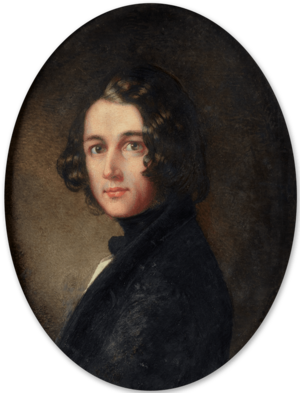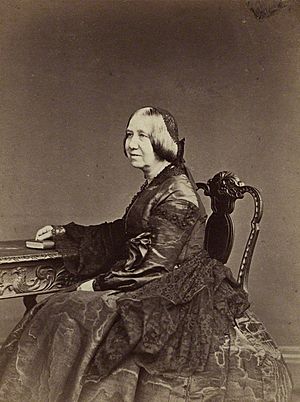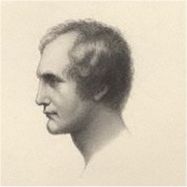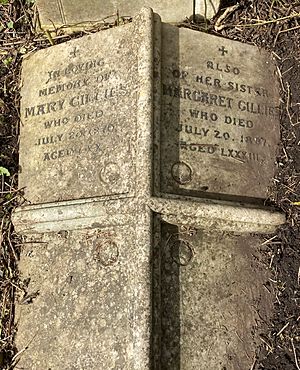Margaret Gillies facts for kids
Margaret Gillies (born August 7, 1803 – died July 20, 1887) was a talented British artist. She was known for painting small portraits called miniatures and for her beautiful watercolour paintings. Margaret was born in London but had Scottish roots.
Contents
Meet Margaret Gillies: A Talented Artist
Early Life and Education
Margaret Gillies was the second daughter of William Gillies, a merchant from Scotland, and Charlotte Hester Bonnor. Margaret and her older sister, Mary, faced challenges early on. Their mother passed away when Margaret was eight, and their father had financial difficulties.
Because of this, Margaret and Mary were looked after by their uncle, Adam Gillies, Lord Gillies. He made sure they received a good education and introduced them to the social life in Edinburgh, Scotland.
Becoming a Professional Artist
Before she turned twenty, Margaret decided she wanted to earn her own living. She and Mary moved back to London to live with their father. Mary became a writer, while Margaret chose to become a professional artist.
Margaret learned how to paint miniatures from an artist named Frederick Cruikshank. She quickly became known for her skill in this type of painting.
Life with Thomas Southwood Smith
In the early 1830s, Margaret and her sister Mary lived with Thomas Southwood Smith. He was a doctor and a pioneer who worked to improve the health of poor people in London.
Margaret and Dr. Smith lived together in Highgate from 1844. Dr. Smith was a Unitarian minister, and Margaret was involved with a Unitarian magazine called Monthly Repository. Her sister Mary even helped edit it. In 1842, Margaret drew pictures for Dr. Smith's first report as a mines inspector.
New Artistic Paths
In 1851, Margaret went to Paris for a year. There, she studied painting in the studios of famous artists Hendrik and Ary Scheffer. When she returned to England, she showed some of her oil paintings. After this, she focused mainly on watercolour painting. She often chose gentle, romantic, or emotional subjects for her art.
Margaret joined the Society of Female Artists in 1856. In 1854, she and Dr. Smith moved to a place called The Pines near Weybridge. However, Margaret kept a studio in London so she could continue her work.
Dr. Thomas Southwood Smith passed away in Florence, Italy, in 1861.
Later Life and Legacy
After Dr. Smith's death, Margaret and Mary Gillies lived for many years in Church Row, Hampstead. They attended the Unitarian Chapel nearby. Mary passed away in 1870.
In early 1887, Margaret moved to The Warren in Crockham Hill, Kent. She died there on July 20, 1887, after a short illness. Margaret taught art to several students, including Marian Emma Chase. She also encouraged other artists like Anna Mary Howitt.
In 1866, Margaret bought a grave plot in Highgate Cemetery. Her sister Mary was buried there in 1870. Other notable people connected to Dr. Smith's family were also buried in nearby graves, including Caroline Southwood Hill, who was Dr. Smith's daughter and the mother of famous social reformers Miranda Hill and Octavia Hill. Although Margaret Gillies is remembered on this grave, she is buried in Crockham Hill.
Margaret Gillies' Famous Artworks
Margaret Gillies was a very productive artist. She had three oil paintings that are now part of national collections in Britain. One art expert, Pamela Gerrish Nunn, said that Margaret combined an older style of art with a very independent way of thinking.
Portrait Artist
During the 1830s and 1840s, Margaret Gillies was a busy portrait artist. She showed her portraits at the Royal Academy exhibitions for many years. She painted many important people, including writers and thinkers. Some of her subjects were Mary Leman Grimstone, Mary Howitt, Harriet Martineau, and the poet Richard Hengist Horne.

One of her most famous portraits is of the writer Charles Dickens. She painted it in 1843, when he was writing his famous book A Christmas Carol. When the painting was shown in 1844, the poet Elizabeth Barrett Browning said it captured Dickens very well. For many years, no one knew where this painting was. But in 2018, it was found in South Africa and brought back to England.
Watercolourist
In 1852, Margaret Gillies became an associate member of the Old Society of Painters in Water Colours. She continued to show her watercolour paintings at their exhibitions for the rest of her life.
Some of her well-known watercolour works include:
- Past and Future (1855)
- The Heavens are telling (1856)
- Rosalind and Celia (1857)
- Una and the Red Cross Knight in the Cavern of Despair (1858)
- An Eastern Mother (1858)
- Vivia Perpetua in Prison (1858)
- A Father and Daughter (1859)
- Imogen after the Departure of Posthumus (1860)
- Beyond (1861)
- The Wanderer (1868)
- Prospero and Miranda (1874)
- Cercando Pace (1875)
- The Pilgrimage (1887)
Her very last painting was called Christiana by the River of Life, which was shown in 1887.





